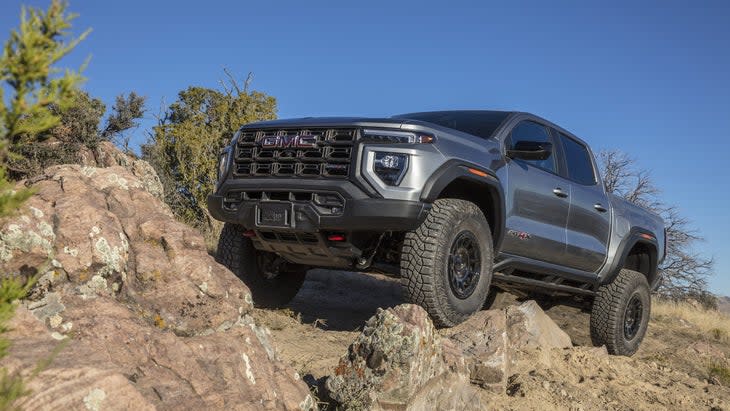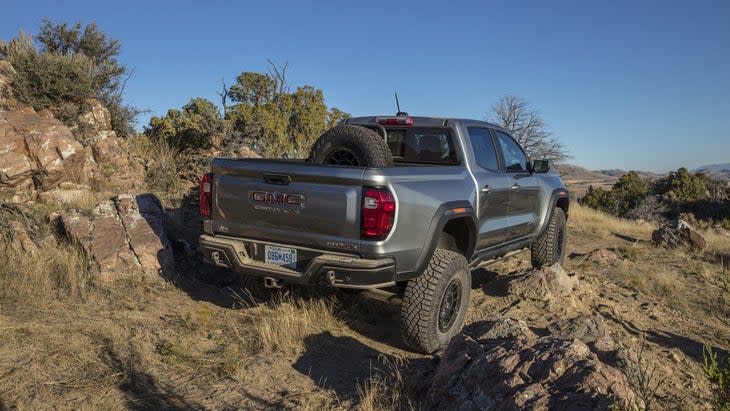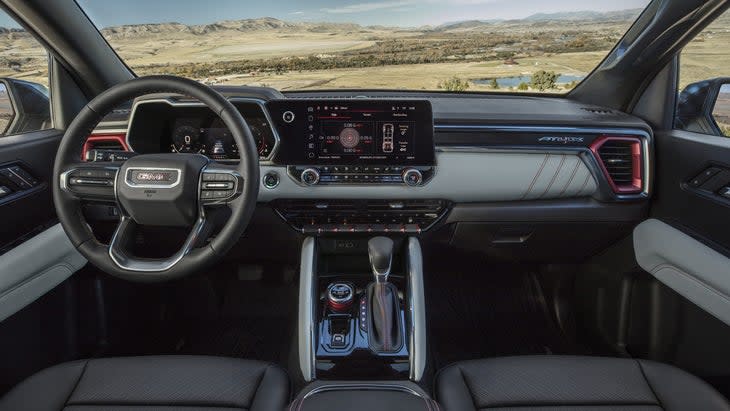Want to Access Remote Public Lands? Here’s Why You Should Buy This Truck.
This article originally appeared on Outside
Want to go further into public lands than ever before? You could buy a dedicated off-roader. You could even spend thousands of dollars modifying a mid-size pickup truck to go off-road. That’s a well-worn path; I’ve gone down that rabbit hole and been more than satisfied. Or, there's another way. Where previous off-road performance trucks have asked buyers to pay a whole lot of money only for not very much suspension, or to focus on one narrow niche at the expense of practical performance, the new 2024 GMC Canyon AT4X AEV Edition creates not only a mouthful of a name, but also a genuine, complete solution to most practical off-road needs.
And, because it's all specified, validated, crash tested, and assembled through the same processes that ensure new vehicles are safe and reliable, the GMC delivers its practicality with a healthy dose of cohesive integration that's simply not achievable in the aftermarket.
Before we dive into GMC's new rig, let’s take a look at why you’d choose a truck for your off-road needs. There's a lake I like to visit not far from my house in southwest Montana that provides a good answer.
The trailhead for that lake is about an hour's drive away on pavement, and the road there follows a twisty river valley, then climbs over a mountain pass. Compared to the solid front axle setup found on dedicated off-roaders like the Jeep Wrangler, the independent front suspension (IFS) like what’s used on most pickups and SUVs delivers a smoother, more responsive ride. My tall, heavy truck will never be a sports car, but the IFS combined with good dampers and spring rates tailored just to my vehicle's unique weight handles the high-speed curves with reassuring confidence. That remains true in rain or light snow, too, thanks to the high-quality all-terrain tires designed just for those conditions.
Turn off the two-land and blacktop quickly gives way to gravel. As soon as it does, I find a flat area to stop and drop my tire pressures from 40 pounds per square inch to 17. The lower pressure lengthens the tire's footprint and makes it more compliant. This helps with traction, puncture resistance, and dramatically improves ride quality across bumpy off-road surfaces. What’s more, I've fitted my truck with 34-inch diameter tires made using more and stronger plies. Taller sidewalls deflated to lower pressures make bumpy dirt roads feel as smooth as driving on the highway.
The road gets rougher as it climbs into the mountains. About a mile in is where trucks pulling trailers give up. A couple miles farther and there's an old gold mine--likely the reason this road was first cut through the woods. That's where most 4×4 drivers turn around. Above that, I've only ever seen other people on foot or riding ATVs. What starts as the occasional boulder poking out of the ground in the middle of the trail eventually turns into rock garden. Without big tires, a truck would struggle to climb them.

Even with drastically improved approach, breakover and departure angles, some of the rocks still rest in places just right to drag along the underside of your doors or catch your rear bumper. Make a slight misjudgment, or lose traction long enough to slide a little bit, and you can collide with those rocks harder than anticipated. To take full advantage of the increased angles I've already spent the better part of ten grand adding to my truck, I then dropped several thousand more bolting on heavy duty steel protection parts under the doors, and in place of the stock bumpers.
We're climbing past 8,000 feet now. The weather radar doesn't penetrate Montana's mountain ranges, and snow or rain can fall at this elevation without warning, any time of the year. Over the steepest rocks, or when surfaces get slippery, you need more traction than 4WD alone can provide. Where 4WD locks the speeds of the front and rear axles together, sending power to the wheel on each with the least traction, locking axle differentials match wheel speeds across axles, sending power to all four wheels. That, combined with very low gears, is what enables off-road vehicles to climb up or down very steep obstacles, or power their way through deep mud and snow.
But there will always be some obstacles you just can't drive through. In shaded spots, which somehow also correspond with the steepest sections of the trail, winter snowpack can linger into July. High winds and wet snow can fell even live trees. Venturing up here without the ability to rescue yourself from a real problem would be foolish. So, any truly prepared 4×4 driver also equips their vehicle with a winch, and all the additional straps, pulleys, and attachment points needed to take full advantage of it.
After months of work and a lot of money, what I've gained is the ability to reliably and comfortably drive up to that lake, catch a few cutthroat trout, and cook them for dinner over a campfire. The big advantage I've bought myself is the ability to do that in a place few, or often no other people are able to visit. And to do all that regularly, both here, and across the vast swaths of America's public land too rugged or remote to get to by any other means.
Doing all this to your truck isn't without downsides. I spent big, luxury truck money on something small and basic because trails like the one to that lake are too narrow for anything else. While I was able to cheaply finance the cost of my truck using low, manufacturer-subsidized interest rates, I had to buy all the rest of the parts for cash, and those totaled more than $25,000. Finding the right solutions involved navigating a market full of incomplete or inaccurate advice in which the majority of products are so poorly made it's hard to think of them as little more than a simple scam. And then I had to take my truck apart and reassemble it with all those new parts, using skills I've developed across a lifetime wrenching on vehicles and by enlisting the help of experts for work I wasn't confident doing myself. Even then, my tires rub the bumpers at full lock in reverse, my rear bumper is rusting to pieces after only three winters, and every single thing I've bolted on comes with its own maintenance schedule or worries, often conflicting with those of other parts made by different companies that they're bolted to. With much improved capability, I've also bought myself a proportionate amount of hassle.

Two weeks ago, I took the new 2024 GMC Canyon AT4X AEV Edition up to that same lake. Despite suspension that's 1.5 inches taller than what’s on my truck, and taller 35-inch tires rather than my 34s, its ride and handling felt like that of a stock vehicle. Because it is a stock vehicle.
Those tires and that lift deliver even better angles than those of my modified truck. The extra half-inch of sidewall smooths out bumps even further, and climbs rocks even easier.
GMC tapped Montana-based American Expedition Vehicles (AEV) to make its bumpers, sliders and skid plates. While my hodgepodge of protection parts is made from a variety of who knows what qualities of steel, AEV employs a proprietary boron steel that's so much stronger than the regular stuff it can be made much thinner and much lighter, while providing substantially more protection. And, unlike the rusty stuff I’ve got, AEV also applies a two-stage electronic, then powder coating process to protect its steel. This results in parts that will last as long and look as nice as the frame and body of the GMC to which they're mounted. I dragged those along as many rocks as I could, and only managed to produce superficial scratches that didn't break through the coating. A dealer-installed Come Up winch is optional, and AEV includes easily accessible, safe shackle attachment points on both the front and rear bumper.
Suspension is provided by Multimatic, and is as well damped and heat-resistant as my very expensive quadruple internal bypass, remote reservoir setup. Not only will you not need to worry about calculating your correct spring rates since GMC has gone through the trouble for you, but unlike any high performance suspension you install yourself, there won't be any need to paint every bolt with a dot of paint, then get a wrench out to make sure everything stays tight, every time you drive it.

Also unlike my truck, in which the interior was modest at best before I took half of it out, GMC delivers modern features like an 11.3-inch touchscreen infotainment system and nice leather trim that feels like it belongs in a truck that will likely cost around $70,000 when it goes on sale sometime in the next couple of months. As a bonus, because all of the AEV protection parts are designed in cooperation with GMC and fitted at the factory, they retain total compatibility with all of the Canyon's sensors and safety systems. Put my truck in reverse and the parking sensors start beeping phantom proximity warnings, while the reverse camera gives me a high-res view of nothing but my spare tire.
Is $70,000 a lot of money for a mid-size truck? I spent about the same building mine, and my result is unquestionably slower, less capable, less comfortable, less protected, and not nearly as well integrated as GMC's. And I had to pay for much of that spend in cash, rather than a single monthly payment. So the question in my mind isn't necessarily the price tag, it's why don't I just sell my truck and buy this?
For exclusive access to all of our fitness, gear, adventure, and travel stories, plus discounts on trips, events, and gear, sign up for Outside+ today.

